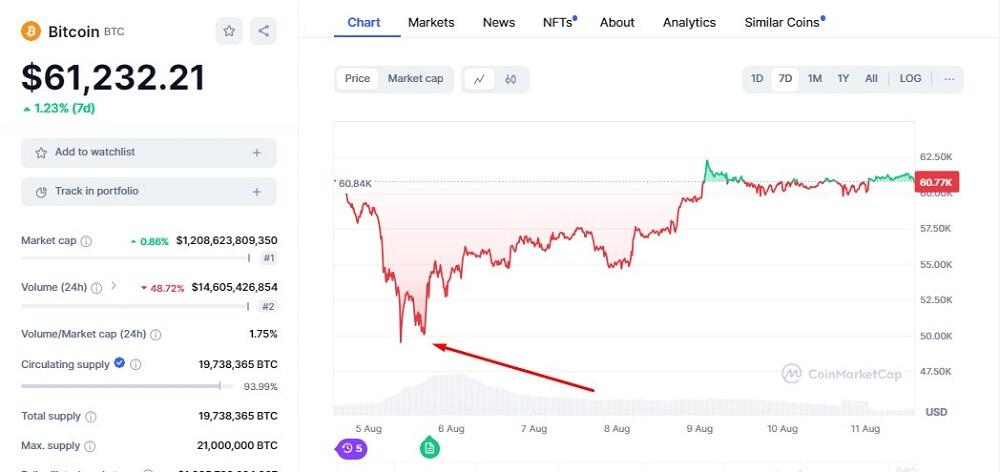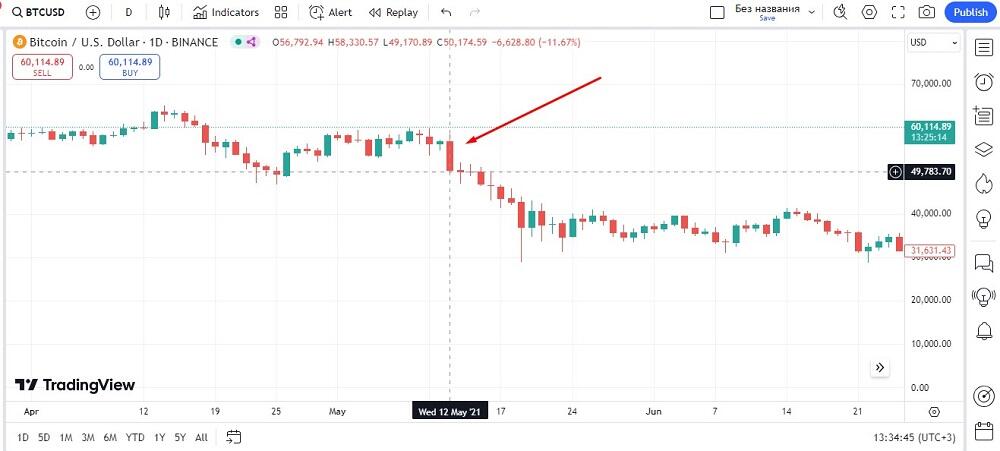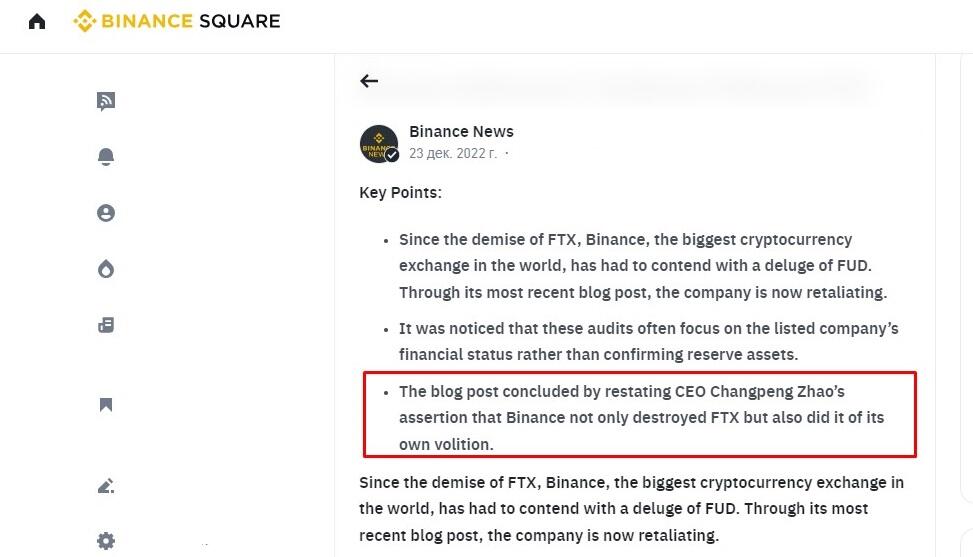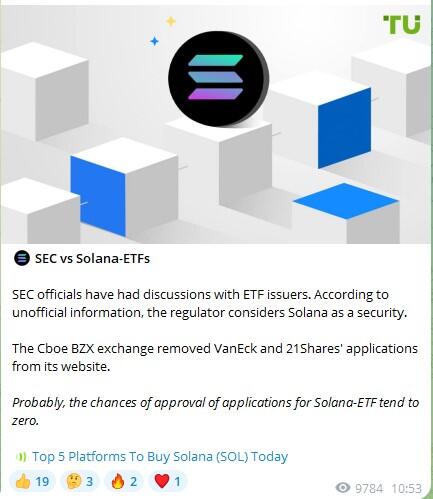
FUD, in the world of crypto, is the negative sentiment in digital assets, affecting everything from individual startups to the entire cryptocurrency market. FUD tends to arise as pessimism grows in the market, often spurred by artificial factors.
Typically, FUD leads to massive sell-offs and price drops. Market makers, such as large funds and investors, often capitalize on this market stance. They deliberately amplify panic to drive the price down and buy cryptocurrency as cheaply as possible. Sometimes, FUD can be targeted at a specific startup to eliminate competition.
What is FUD in crypto? What are its triggers and consequences? How can traders and investors make the most profitable decisions during FUD? Find the answers in this article.
The article covers the following subjects:
Key Takeaways
|
Main theses |
Conclusions and highlights |
|
FUD Definition |
FUD in crypto markets is any information that is interpreted negatively by market participants. |
|
FUD Types |
|
|
FUD Tools |
|
|
FUD’s Impact On The Market |
Most commonly, FUD results in rush sell-offs. Traders and investors close their trades and withdraw their money from the market to wait out the downturn in cash. Once the first traders exit the market and the price starts to decline, others follow suit amid the negative news, causing a chain reaction of panic selling. |
|
How Traders Should Deal With FUD |
Monitor the volatile market and assess news reliability and impact. Avoid using leverage and set a stop-loss order. Look for buying opportunities at the end of a correction. |
|
How Investors Should Deal With FUD |
Stay calm and remember that an investor is a long-term player. Cryptocurrencies have repeatedly plummeted by more than 60% but have recovered afterward. You should only close your trades with profits. |
What is FUD: How It Affects Crypto Markets and Investors
FUD is an abbreviation for fear, uncertainty, and doubt. The term has several following meanings:
-
a psychological manipulation tactic aimed at spreading anxiety among cryptocurrency holders, prompting them to sell or tarnishing the reputation of a particular startup;
-
any negative news regarding cryptocurrencies that may lead to disquiet in the market.
The price of an asset is determined by supply and demand, which reflects the interest of traders and investors in the asset. If an asset is appealing, people buy it, increasing purchase volume and an asset’s price. Conversely, when an asset loses its appeal, the price decreases. The attractiveness of an asset is influenced by news. Positive news elevates the crypto prices, while negative events drag them down.
News can be classified into three groups:
-
Facts. Information about an event in the world of cryptocurrencies is presented without bias. Thus, the public is allowed to draw their own conclusions. However, facts can also be manipulated. For example, only favorable information may be shared, omitting the other side of the coin.
-
Biased judgments, whether right or wrong, can be a part of FUD or simply subjective viewpoints. A prime example is the speculative statements made by certain influential individuals like Craig Wright or Elon Musk, which can cause market dismay. However, only impulsive traders, often referred to as “hamsters,” might react irrationally, as the opinion holders probably do not have the intention to manipulate prices.
-
FUD includes deliberate manipulative strategies involving disseminating specific information and establishing negative contexts to sway traders and investors into making decisions that benefit the manipulators.
FUD may also encompass the biased presentation of statistics and analytical data from the crypto industry.
Although FUD may have different meanings, it unequivocally conveys a negative connotation toward cryptocurrencies, whether temporary or permanent. It negatively impacts market sentiment, resulting in reduced confidence and a bearish trend.
FUD can take several forms:
-
News and rumors. Dissemination of news by media representatives, especially on crypto social media, or spreading rumors that are partially or entirely false. This may include news reports about the prohibition of cryptocurrencies in a specific country, the collapse of a prominent crypto-related company, or the introduction of new regulatory measures limiting the use of digital assets.
For example, a regular topic for headlines during the autumn–winter of 2023 was the speculation about whether the US SEC regulator would permit spot ETF funds. The prevailing sentiment was quite negative, which restrained Bitcoin’s growth.
-
FUD on social media. Social media or forums deliberately spread comments, posts, and messages aimed at generating a negative sentiment among market participants. Individuals or groups can use this tactic to influence market performance.
FUD can be used to smear the reputation of competitors, including individual startups. This method has been quite effective lately, especially regarding new tech startups, airdrops, and coin sales before the official release. The primary platform for spreading such information is the cryptocurrency channels on Telegram.
-
Famous figures’ statements. Influential personalities, such as cryptocurrency startup owners or fund directors, may share unfavorable views regarding cryptocurrencies, leading to a surge of doubt among investors.
Traders most commonly follow the statements of Elon Musk, US SEC chair Gary Gensler, and MicroStrategy chair Michael Saylor.
-
Negative statistics and analytics on the cryptocurrency market or particular startups are presented deliberately from a specific perspective. When this negative information is widely disseminated across various news channels, it creates a domino effect, leading traders to believe that everything is going downhill and that they should sell. Therefore, it is crucial not to place too much reliance on external factors that may sway your decisions, instead, conduct your own analysis and perform due diligence.
For example, a news channel publishes information that Mt.Gox investors will be paid 1,000 BTC. However, the channel does not specify that this amount is insignificant for the crypto market, as investment funds are poised to purchase the entire volume. Besides, this news does not disclose that the compensation will be provided in cash as in the case of compensation to FTX investors, and this money can potentially be reinvested in the crypto ecosystem, generating additional demand.
FUD should also be considered as an opportunity to increase the volume of a position at a more favorable price. If the price falls on the backdrop of negative news, consider buying coins. When the market recovers, you will gain profit.
FUD Origins
FUD can have two origins — natural and artificial. It occurs naturally when negative news is objectively grounded, leading to a continuous stream of negative reports and creating a seamless flow. Thus, the cryptocurrency market accumulates negative information, and a single piece of news is enough to trigger dismay and a plunge in quotes.
For example, sometimes market capitalization expands due to unfounded optimism when there are no fundamental reasons. When people notice that cryptocurrency prices are rising, even without solid backing, they start buying the asset, driving up demand and pushing the price higher. However, suppose news breaks that a major player like Black Rock is selling some of their cryptocurrency, combined with the US SEC regulator imposing new claims on cryptocurrency exchanges. In that case, the negativity accumulates, and sell-offs begin.
This kind of FUD poses a significant challenge as it is difficult to predict how low the market cap will plummet. Moreover, it is difficult to determine how quickly and whether the price will recover at all.
Artificial FUD is mainly controlled and is short-term. Organizers aim to utilize various tactics to instill fear, uncertainty, and doubt among speculators, creating a negative environment that prompts selling. Eventually, major investors, according to the smart money concept, buy the entire sales volume, and the market turns bullish again.
Causes of FUD:
-
Market manipulation. It may occur when large traders aim to drag the price down and enter the market at a more attractive price. For example, a major fund may anticipate a forthcoming US SEC announcement that could elevate the price. To take advantage, they might spread negative news to start a selling frenzy. As a result, many traders close their transactions, the price declines, and the fund purchases the cryptocurrency at a lower price.
-
Competition among different cryptocurrencies or projects can lead to campaigns aimed at discrediting rivals by spreading FUD. An example is the undisguised mutual FUD campaign between Binance and the currently bankrupt FTX.
-
Regulators’ actions and legal restrictions. Regulators may deliberately or unintentionally cause a wave of FUD. For instance, litigation between SEC and Binance, Coinbase, and Ripple may trigger this effect. The same is true for new laws and regulations. Any bans or attempts to bring cryptocurrencies under control or impose a tax are perceived negatively.
FUD is not necessarily a meticulously planned scheme carried out by a single instigator. Typically, negative news emerges in the market, and the media, benefiting from any attention-grabbing material, spreads it. The FUD instigator simply needs to ignite the spark, and the community will then propagate the news, often presenting the information in a biased and subjective manner.
Analysts also contribute to FUD, using their expert judgment to sow disquiet and benefit from it. Then “hamsters” come into play, starting a panic selling fueled by negative news from the media, including cryptocurrency news channels.
FUD consequences:
-
Fear and loss of trust in a particular startup and its developers, the crypto industry, exchanges, and cryptocurrencies, in general, may cause a “hamster” who emotionally bought and sold an asset to think twice before taking a risk again.
- High volatility often triggers massive sell-offs, with the market subsequently recovering in a relatively brief period. However, this pattern does not always hold true. In cases of widespread hysteria, the market may experience multiple collapses without significant recovery.
The main consequence of FUD is the asset’s sell-off and decrease, potentially leading to a long-term bearish trend.
When Does FUD Occur and Famous Examples
Negative news saturates the media, often overshadowing positive reports. When negative news dominates the market, it can lead to FUD, triggering rush sell-offs, market downturns, or problems for particular startups and platforms.
In the early years of digital assets, FUD was not as widespread. The cryptocurrency community only started paying attention to it closer to 2017. A prime example of FUD occurred when the People’s Bank of China banned ICOs in September 2017, causing Bitcoin to drop by over 8% in just one day. The same year, China prohibited mining. Whenever there is news of a country planning to ban or heavily regulate cryptocurrencies, it often sparks FUD.
Bitcoin
In the early days of August 2024, the following news were released:
-
Weak economic data in the US. The country’s economy faced the possibility of recession. Stock indices gained bearish movement, prompting investors to exit high-risk assets, converting them into cash.
-
Kamala Harris has tied with Donald Trump. She is perceived as an opponent of cryptocurrencies, while Trump, on the contrary, is a supporter. Therefore, as Harris’ popularity rose, investors started to sell cryptocurrencies gradually.
-
Israel and Iran continue to exchange mutual threats, creating a negative perception among investors regarding any military actions in the East.
-
The Bank of Japan has raised the discount rate twice in six months for the first time since 2008. Investors began to buy the yen, considering it a safe-haven asset.
-
The court ordered the bankrupt exchange Genesis to pay 77% of its debts. A month before that, Germany and the UK started to sell their crypto assets, including Bitcoin, putting additional pressure on the market.
-
The fear and greed index has decreased from 76, indicating greed, to 24, indicating fear, during the week.
Each piece of news separately would not dramatically impact the cryptocurrency market. Nonetheless, the media accidentally or deliberately focused on negative news in late July and early August, creating an impression of a general negative environment.
As a result, the Black Monday of August 5 led to a 28% drop in Bitcoin’s price, a 34% decrease in Ethereum, and a 41.6% plunge in Solana.
Major BTC holders like Black Rock and MicroStrategy did not sell their assets. In fact, some of them even purchased more. Their decision proved to be right, as the price of Bitcoin rebounded at the beginning of the following week after the panic caused by FUD.
On the 12th of May 2021, Elon Musk tweeted (on current X) that Tesla would no longer accept Bitcoin as payment for cars, which caused the cryptocurrency to lose 10% of its value in just one day, illustrating another instance of FUD.
Binance
By the time the FTX exchange went bankrupt, there was fierce competition between Changpeng Zhao and Sam Bankman-Fried. Changpeng Zhao played a significant role in FTX’s downfall by withdrawing all the funds from the exchange token FTT. However, this action caused issues for Binance.
After the collapse of the FTX exchange, Binance was hit with a barrage of FUD, raising concerns about the exchange’s financial capabilities and whether it was another potential bubble company like FTX.
The exchange was forced to release an official statement including the following points:
-
the reasons for the suspension of the USDC stablecoin withdrawal;
-
report on the exchange’s reserves and its ability to fulfill its liabilities;
-
response regarding the relations with the auditors.
Later, Binance became embroiled in a legal dispute with the US SEC, leading to FUD among users and prompting some to shift to other exchanges. However, the issue was resolved after reaching a mutual agreement with the regulator, resulting in a fine for Binance and a prison sentence for Changpeng Zhao.
ICO
Furthermore, many FUD occurrences often surface in the midst of ICOs, IDOs, and listings, making it challenging to pinpoint its specific target. The more uncertain the situation, the more fear and insecurity investors experience.
Solana, for instance, is a major competitor to Ethereum in the decentralized application platform space due to its impressive network capacity. However, FUD is constantly emerging in the crypto space. News headlines often highlight issues like Solana’s system malfunctions and decreasing TVL (total value locked). This kind of news is unlikely to attract investments into startups planning to utilize the SOL blockchain. The prevalence of FUD could have a detrimental impact on Solana and investors’ willingness to provide endorsement to projects on its platform in the long run.
While the article was in progress, another piece of news appeared. The US SEC is going to classify SOL as a security. Below, you can see how this news was presented by Telegram channels.
Market and Trader Reactions to FUD
The extent of FUD’s influence is not as crucial as a trader’s response to it. On the one hand, logic suggests that you should not blindly believe the news, as any information can be biased. On the other hand, if you ignore FUD while others get anxious and sell their cryptocurrency, causing its value to plummet, will that make you feel better?
What investors and traders should do if FUD occurs:
|
Traders |
Investors |
|
1) Analyze news from different angles and try to find the original source. Different sources may report the same news in different ways, which may lead to diverse interpretations by traders. The information may be presented negatively if the media has misconstrued or downplayed certain aspects.
For example, on August 14–15, 2024, news reported that the US was selling 10,000 BTC associated with the Silk Road dark web marketplace. However, it turned out that the US authorities only transferred 10,000 BTC to Coinbase accounts. |
1) Avoid panic. As a long-term investor, you understand that cryptocurrencies are poised for growth in the coming 1–3 years. This is a demanded technology that is gradually being accepted by regulators and integrated into national economies along with traditional fiat currencies. |
|
2) Look for positive news, as they may outweigh the impact of FUD.
For example, it may seem negative when the media announces news such as the US SEC suing Ripple or Coinbase again. At the same time, Black Rock and MicroStrategy are buying Bitcoin, which shows their confidence in its growth. In the long term, this vote of confidence is a much stronger indicator of potential growth. |
2) Make sure to transfer your crypto-assets to cold wallets as a precaution in case there is a drop in liquidity or if exchanges encounter issues during a major panic. |
|
3) Set stop orders if there is a risk that your positions may be closed or liquidated by a stop-out. |
3) Never sell at a loss. A correct conservative strategy suggests that if you have bought an asset at a lower price, you should sell it at a premium price. If the price falls below the breakeven point, wait for the drawdown to end. |
|
4) Close your trades and look for new entry points. If the price has declined, terminate your transaction. Once the correction is over, open a new long trade. If the correction turns out to be a global recession, you will at least avoid further financial losses. |
4) Follow the average down strategy. Averaging is an investment strategy in which an investor regularly commits a fixed amount of money to a cryptocurrency, regardless of its current price. For example, if Bitcoin drops below the purchase price, buying more at the lowered price may be advantageous, as it is expected to increase in value over time. |
|
5) Stay positive. If you have invested in a new startup and it has irrevocably depreciated after listing, do not worry. This is a risk you have to consider. Thus, it is crucial to have a diversified portfolio. |
Frequent negativity towards cryptocurrencies undermines their credibility. The media, trying to attract the audience with a sensational or misleading headline, fuels the FUD spread. Although the market is susceptible to rapid declines, recovering may take a long time.
A timeless recommendation for traders and investors applies here as well. Diversify your portfolio and learn to restrain your emotions. If one startup is on the verge of collapse due to FUD, there are other projects that will recover after the slump. Emotional control is one of the keys to success in cryptocurrency trading. Invest while others are selling, and conversely, sell when others are artificially driving up the cryptocurrency market.
How to identify FUD:
-
Rely only on reputable analytical websites like CoinMarketCap and Glassnode, which publish accurate data and charts frequently, ensuring an impartial representation of facts. Be wary of Telegram or YouTube channels that spread fear by declaring, “All is lost! You need to sell! This startup is a scam!”. Always exercise caution, as these could be fraudulent schemes.
-
Monitor market sentiment indicators such as the fear and greed index. The original version of the index is calculated by CNNMoney, and the alternative one is computed by the analytical portal Alternative. The 0–25 value means extreme fear and panic. However, some sources advise considering this as a buying opportunity. If the index reaches 75–100, it indicates extreme greed, illustrating the prevalence of FOMO sentiment when cryptocurrencies are bought on emotions.
-
Verify the information contained in the media by looking for statements from developers or officials in the source language. For example, if you come across news that “A startup A was hacked, and investors’ losses amounted to more than X USDT,” it could actually mean that “A white hat hacker identified a vulnerability in startup A and returned the money obtained from the hack. The developers rewarded the hacker with a 10% bounty.”
Moreover, you should not only confirm the reliability of information or the fact of manipulation but also predict the behavior of the majority of market participants. If the market embraces the news, then your personal assessments will not matter. The key point is to understand how the crowd will react and how the cryptocurrency will be traded. Therefore, the news serves as the initial catalyst, and the market’s response is the principal determinant.
Differences Between FUD and FOMO
FOMO, or fear of missing out, is a state of anxiety or worry caused by the fear of missing out on something important or beneficial.
FOMO Key Features:
-
Fear of missing out. Worry that others are profiting while you are missing the opportunity. For example, suppose that Bitcoin traded at $16,000, but you hesitated to buy it, fearing a price drop, yet the price climbed to $60,000. As a result, you experience FOMO and try to grasp the last opportunity, buying at the peak price and suffering losses.
-
The urge to stay updated and not miss out on important events, news, or opportunities. Trying to take in everything at once. Failing to do so can result in self-criticism, leading to a drop in self-esteem.
-
Comparing oneself to others. Constant comparison with others and their achievements. Thoughts like “They earn more,” “Why are they succeeding while I’m failing,” and “I cannot do anything” are characteristic of this mindset. In psychology, this condition is known as FOMO.
Let’s explore the differences between FUD and FOMO in more detail using a comparison table:
|
Causes |
|
|
FUD |
FOMO |
|
|
|
Consequence |
|
|
FUD |
FOMO |
|
|
|
Impact |
|
|
FUD |
FOMO |
|
|
|
Emotions |
|
|
FUD |
FOMO |
|
|
When it comes to similarities, both FUD and FOMO are heavily influenced by emotions. FUD prompts traders to panic and sell their assets due to fear of potential losses, while FOMO drives them to buy assets out of greed and the influence of hype.
Common FUD-Related Myths and Misconceptions
Let’s examine the most frequent statements that spread negativity in the market and should be debunked.
1. Cryptocurrency is a bubble.
This statement is only partially true, but it contributes to the fact that Bitcoin still does not exceed $100,000, as some market analysts predicted. Cryptocurrencies are coins and tokens of particular startups, each serving a different purpose. Unfortunately, the market is saturated with numerous pointless projects like meme coins and ventures that lack viable revenue streams. Despite this, cryptocurrencies represent the future of technology. Yet, we cannot rule out the possibility of a recurrence of a dotcom crash.
2. Cryptocurrencies have no real value.
Cryptocurrency prices are often speculative, but they still hold value based on the usefulness of the specific cryptocurrency to society. For instance, Bitcoin functions as a payment network, Uniswap operates as a decentralized exchange, and Decentraland offers a gaming meta-universe.
3. Cryptocurrencies are likely to lose their anonymity and come under regulatory supervision in the future.
Central banks manage national economies by regulating the monetary balance. The unregulated nature of cryptocurrencies poses risks, such as the existence of a shadow market and tax evasion. Therefore, countries are progressing towards developing their own Central Bank Digital Currencies (CBDCs). However, the anonymous cryptocurrency market is likely to continue to exist alongside these efforts, as it is unlikely to be fully regulated.
4. Cryptocurrency values are controlled by market makers who have the ability to manipulate and disrupt the market at any given moment.
This concept is more mythical than truthful. The price may indeed depend on large capital. However, it does not make sense for market makers to offload cryptocurrencies, especially when they would also suffer from the resulting price drop unless the purpose is to drive the price down in order to buy more.
5. Cryptocurrencies are highly volatile. You can lose money at any time.
Yes, the crypto market’s volatility can reach 10% or more per day. Nevertheless, avoid being swayed by FUD, refrain from using leverage, opt for long-term investments, and the changes in volatility won’t have any significant impact.
6. Investing in crypto involves unreasonable risks as the price can collapse at any minute under regulatory and FUD pressure.
Indeed, the market can lose over 50% of its capitalization in a few weeks. However, only inexperienced investors and traders can experience FUD during such periods. The examples of 2018 and 2021 show that a significant downturn presents an opportunity to purchase assets at a low price, which then exceeds its all-time highs. Nevertheless, many people become pessimistic during a downturn and try to get rid of their assets. As a result, experienced market players use this behavior to their advantage.
Conclusion
FUD represents the general market sentiment and is unavoidable no matter how much you keep up with the news. It is important to conduct your own thorough analysis rather than relying solely on FUD. Whether to trade during FUD, purchase when the market is down and average your positions, or wait it out is entirely up to you. Let’s summarize briefly:
-
FUD in the crypto market encompasses any negative factors, such as unfavorable news or events that induce panic and fear among traders, compelling them to sell their assets;
-
FUD can result from a combination of negative events that lead to a pessimistic sentiment. It can also be instigated by the dissemination of false information to manipulate prices or discredit competitors.
-
the consequence of FUD is selling in a hurry, driving the price even further down;
-
When dealing with FUD, you should rationally assess the situation. If the market is expected to rebound in the future, there is no point in selling the cryptocurrency. However, if a particular cryptocurrency seems unlikely to recover, consider selling at a loss.
FUD In the Crypto Market FAQ
The term FUD in cryptocurrencies refers to the spread of negative information or rumors that can affect the cryptocurrency market, causing panic among investors and a decline in coin prices due to a subsequent selling frenzy.
The acronym FUD, commonly applied in the context of the cryptocurrency market, stands for fear, uncertainty, and doubt.
These are different psychological responses with different consequences. FUD involves psychological manipulation to persuade a person to commit a particular action by instilling fear and uncertainty. FOMO, on the other hand, is a lost opportunity syndrome. People experiencing FOMO feel they must take action, even if it is not the right decision.
Monitoring FUD includes unbiased analysis of FUD news, media persons’ subjective opinions, information from specialized channels, and statistical information. Objective analysis implies searching for news in the primary source, gathering data from diverse outlets, and seeking alternative positive news to counterbalance any negativity arising from FUD.
Solana has experienced the most prolonged FUD case. During 2021–2022, the platform faced a series of problems, such as frequent network disruptions, outages, security breaches, and hacker attacks. This raised concerns about the network’s reliability and its ability to compete with Ethereum. As a result, the platform failed to regain its lost credibility amid negative rumors. A tweet from Changpeng Zhao on November 6, 2022, created a well-known short-term FUD when he expressed a desire to sell his FTT tokens, adding to the ongoing rivalry between FTX and Binance exchanges. The tweet ultimately led to the FTX exchange declaring bankruptcy a few days later.
The content of this article reflects the author’s opinion and does not necessarily reflect the official position of LiteFinance. The material published on this page is provided for informational purposes only and should not be considered as the provision of investment advice for the purposes of Directive 2004/39/EC.
{{value}} ( {{count}} {{title}} )
This post is originally published on LITEFINANCE.








